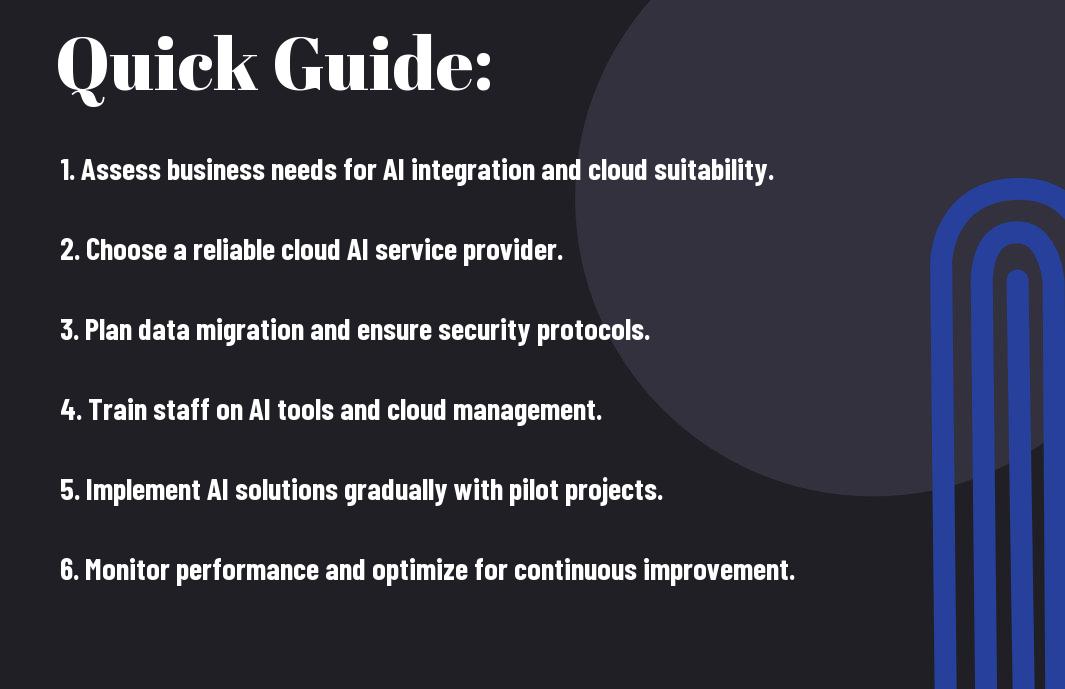You have the opportunity to transform your business through the innovative use of cloud-based AI solutions. This guide will provide you with the necessary steps to leverage these technologies effectively. By embracing these tools, you can enhance operational efficiency, reduce costs, and gain a competitive edge in your industry. However, navigating this landscape can also present challenges, making it imperative for you to approach implementation thoughtfully to avoid potential pitfalls. Let’s explore how you can unlock the full potential of AI to elevate your business strategy.

Key Takeaways:
- Cloud-based AI solutions offer scalability and flexibility, allowing businesses to adapt and respond to changing market demands quickly.
- Implementing AI requires careful planning, including defining clear objectives, choosing the right tools, and ensuring seamless integration with existing systems.
- Continuous monitoring and evaluation of AI performance are vital to optimize outcomes and make data-driven decisions that enhance business efficiency.
Harnessing Cloud Infrastructure for AI Strategies
Utilizing cloud infrastructure provides businesses the agility needed to propel their AI strategies forward. By tapping into cloud services, you gain access to powerful computing resources and scalable storage solutions necessary for handling vast datasets. Cloud-based AI platforms enable your team to quickly deploy machine learning models and harness advanced analytics without the burden of managing on-premises infrastructure. Explore how businesses leverage AI and data engineering for operational breakthroughs as you integrate these solutions.
Choosing the Right Cloud Provider
Selecting a suitable cloud provider is important for aligning your AI strategy with business goals. Evaluate providers based on their AI capabilities, available services, compliance standards, and support infrastructure. Each provider offers unique tools or integrations that may enhance your AI projects, so identifying the right match can significantly impact your operational efficiency.
Evaluating Infrastructure Needs and Scalability
Assessing your infrastructure requirements and scalability potential is fundamental to ensuring a successful AI implementation. Factors like anticipated data growth, user demands, and computational workloads all play a role in determining what you will need. Having a solid plan to accommodate your AI solutions is not just about meeting current needs; it’s about future-proofing your business against evolving technological landscapes.
Begin by analyzing your current workloads and projecting future growth to calculate your capacity requirements. Usage patterns, such as peak periods of demand or expected expansion into new markets, should inform your decisions. Scalability options, such as auto-scaling features in cloud services, allow your infrastructure to adjust dynamically, ensuring you pay for only what you use while maintaining optimal performance. Partnering with the right cloud provider can provide you with the necessary architecture that adapts as your AI initiatives grow and evolve, driving efficiencies and reducing time to market.

Crafting Tailored AI Solutions
Customizing your AI solutions enhances effectiveness and aligns technology with your unique business needs. Assess your current operations and specific challenges to forge solutions that genuinely drive results. Approaching AI with a tailored mindset not only anticipates obstacles but also maximizes potential gains. By investing in these personalized strategies, you open pathways to innovation. Learn more about this by checking out Unlocking AI Innovation: Why Moving Your Business to the Cloud is Key.
Identifying Business Goals and AI Applications
Start by pinpointing the core goals your business aims to achieve, such as improving customer service or streamlining operations. Consider applications of AI that align with these objectives, like implementing chatbots for quicker customer response times or predictive analytics for inventory management. These targeted applications enhance productivity and open new avenues for growth.
Customizing AI Models for Specific Use Cases
Tailoring AI models involves adjusting algorithms and training data to fit the nuances of your specific business context. This ensures the AI learns from relevant information, producing precise outcomes that support decision-making. For instance, a retail business may leverage customer purchase history to personalize marketing strategies, while a manufacturer could use customized AI for predictive maintenance, anticipating machinery failures before they disrupt operations.
Implementing customized AI models requires collaboration between data scientists and domain experts to achieve optimal accuracy. As you refine these models, consider using diverse datasets that reflect seasonality or customer preferences. This approach minimizes biases and ensures your AI adapts dynamically to changing trends. You can employ iterative testing to assess performance and continuously improve the solutions based on real-time data feedback, keeping your business agile and responsive.
Data Management: The Backbone of AI Success
Effective data management serves as the foundation for AI initiatives within your organization. Without a robust system for collecting, storing, and processing data, even the most sophisticated algorithms can falter. By establishing well-defined workflows and utilizing cloud-based platforms, you create the necessary infrastructure for your AI projects to thrive. Investing time in understanding your data sources and the lifecycle of your data will directly impact the success of your AI efforts.
Strategies for Efficient Data Collection and Storage
Implementing automated data collection tools and leveraging cloud infrastructures streamline and simplify the storage process. Integrate APIs for real-time data ingestion, creating a seamless flow of information suitable for analysis. Choose scalable storage solutions that accommodate your growth, ensuring easy access while maintaining data security. Building a data pipeline that automates these processes not only boosts efficiency but also minimizes human error.
Ensuring Data Quality and Compliance
Data quality and compliance are non-negotiable factors in your AI strategy. Regular audits and validation processes can identify inaccuracies before they impact outcomes. Furthermore, adhering to industry-specific regulations, such as GDPR or HIPAA, safeguards your organization against potential fines and reputational damage. Training staff on data handling best practices solidifies a culture of responsibility around data usage.
Investing in data governance frameworks is vital for upholding data quality and meeting compliance requirements. For example, using automated tools for data cleansing helps identify and correct discrepancies, ensuring that your AI models operate on accurate datasets. Creating a comprehensive compliance checklist relevant to your industry will guide you through legal requirements and foster a proactive approach. By establishing regular training sessions and workshops, your team will stay informed about evolving regulations and best practices, further enhancing the integrity of your data management efforts.
Integrating AI with Existing Systems
Integrating AI solutions with your existing systems is crucial for maximizing their potential and ensuring streamlined operations. This process involves assessing how current technologies interact and identifying opportunities to embed AI capabilities, thus enhancing decision-making and automation. You’ll want to focus on system compatibility, ensuring that new AI tools can easily mesh with your established frameworks, which will save time and resources while boosting productivity and innovation.
Seamless API Connections and Workflow Automation
API connections facilitate the integration of AI into your existing systems, enabling seamless data exchange and communication. By implementing well-designed APIs, you can automate workflows and eliminate repetitive tasks, allowing your team to focus on strategic initiatives. For instance, integrating an AI chatbot with your CRM system can automate customer interactions, streamlining sales processes and improving customer satisfaction.
Overcoming Barriers to Adoption and Integration
Embracing AI comes with challenges, particularly when integrating it into existing systems. Resistance to change, lack of technical expertise, and data compatibility issues can hinder successful implementation. Addressing these obstacles head-on with a clear strategy is vital. Training your workforce and showcasing the long-term benefits of AI adoption can foster a culture of innovation. Furthermore, prioritizing your system upgrade and modernization can help equip your infrastructure to handle new AI applications effectively.
Addressing barriers to adoption and integration requires a multi-faceted approach. Organizations often face pushback from employees concerned about AI replacing their roles; thus, emphasizing the augmentation of jobs instead of replacement can shift mindsets. Additionally, the complexity of existing legacy systems may require a phased integration strategy, where you gradually enhance capabilities rather than overhaul everything at once. Collaborating with AI solution providers who understand your industry can ease the integration process, ensuring that you leverage their expertise to navigate technological pitfalls effectively.
Measuring ROI: The Impact of Cloud-Based AI
Assessing the return on investment (ROI) for cloud-based AI solutions demands a multi-faceted approach. By evaluating operational efficiency, cost savings, and revenue growth, you can quantify the impact of AI. For instance, companies leveraging AI have reported up to a 40% reduction in operational costs, translating to significant savings over time. Additionally, improved customer insights often lead to a 20% increase in sales, highlighting the financial benefits of implementing AI effectively.
Key Performance Indicators for AI Initiatives
Tracking the success of your AI initiatives involves defining clear key performance indicators (KPIs). Metrics such as customer satisfaction scores, conversion rates, and operational efficiency ratios can provide insight into the effectiveness of your AI tools. By regularly analyzing these KPIs, you gain a tangible sense of the value generated by AI, allowing for informed adjustments to your strategies.
Long-term Benefits and Sustainability
Investing in cloud-based AI yields long-term sustainability benefits that go beyond immediate results. Organizations typically experience enhanced agility, enabling swift responses to market changes. This adaptability fosters innovation, creating opportunities for new product offerings and services. Furthermore, sustainable business practices facilitated by AI contribute to reduced resource consumption and lower environmental impact, aligning your organization with growing concerns for ecological responsibility.
Long-term sustainability extends beyond operational savings to cultivate a forward-thinking organizational culture. As AI continually evolves, your business remains equipped to leverage data-driven insights for strategic planning. This adaptability creates a competitive edge in rapidly changing landscapes, ensuring that your investments not only bolster profitability but also support responsible growth. Engaging in AI initiatives helps create a culture that embraces innovation, ultimately driving sustained success in the marketplace.
To wrap up
Upon reflecting, utilizing cloud-based AI solutions can significantly enhance your business operations and decision-making processes. By strategically implementing these technologies, you can improve efficiency and stay competitive in your industry. Embracing this innovation doesn’t have to be daunting; a structured approach can guide you through the integration process. For more insights on this transformative shift, you can explore the resource on Unlocking the Power of Cloud-Based Solutions – emite.
Q: What are cloud-based AI solutions, and how can they benefit my business?
A: Cloud-based AI solutions utilize artificial intelligence technologies hosted on cloud infrastructure, allowing businesses to leverage powerful AI capabilities without the need for extensive on-premises hardware. These solutions can help enhance business operations through improved data analytics, personalized customer experiences, automation of repetitive tasks, and better decision-making processes. By adopting cloud-based AI, businesses can scale their AI capabilities more easily, reduce upfront costs, and gain access to the latest AI advancements without constant updates or maintenance.
Q: What steps should a business take to integrate cloud-based AI solutions effectively?
A: To integrate cloud-based AI solutions successfully, a business should start by identifying specific problems or objectives that they aim to address with AI. Next, they should evaluate different AI tools and platforms available in the cloud to find the one that aligns with their needs. Following this, developing a roadmap for implementation, which includes securing necessary resources and training for staff, is necessary. Continuous monitoring and optimization of AI applications should be maintained, ensuring the solutions evolve alongside changing business objectives and technological advancements.
Q: How do I ensure the security and privacy of data when using cloud-based AI solutions?
A: Ensuring data security and privacy while using cloud-based AI solutions involves several important steps. First, select a reputable cloud provider that complies with industry standards and regulations regarding data protection. Implement end-to-end encryption for data both at rest and in transit to safeguard it from unauthorized access. Additionally, establish robust access controls and authentication measures to allow only authorized personnel to handle sensitive information. Regularly review and update data protection policies and invest in employee training for cybersecurity awareness to minimize risks associated with data breaches.







